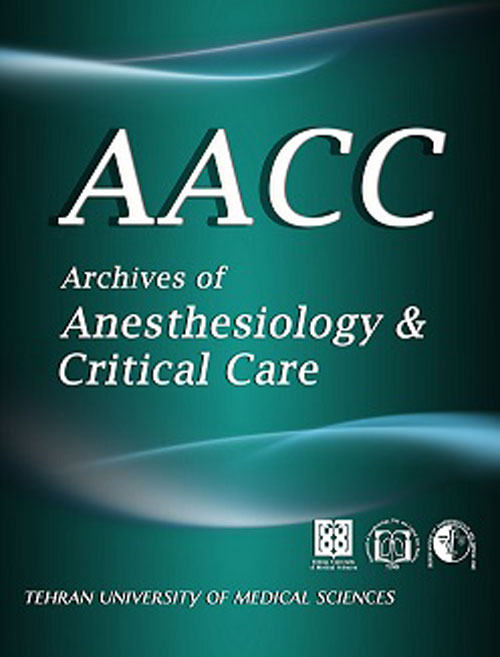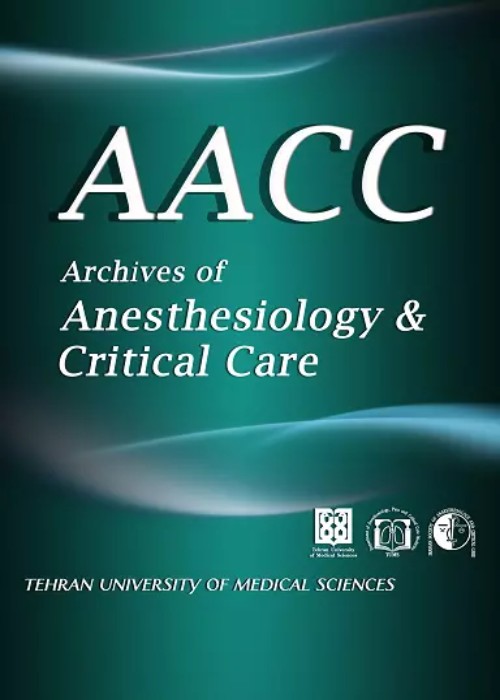فهرست مطالب

Archives of Anesthesiology and Critical Care
Volume:2 Issue: 3, Summer 2016
- تاریخ انتشار: 1395/06/10
- تعداد عناوین: 7
-
-
Pages 203-206BackgroundPain control after traumatic maxillofacial surgery due to severity of pain and limitations of opioids use in these patients is of particular importance. The aim of this study was to evaluate the multimodal analgesic effect of oral gabapentin and intramuscular ketorolac in combination with intravenous acetaminophen for pain control after remifentanyl infusion in this surgery.MethodsThis study was a randomized clinical trial (RCT) on 60 patients (18-45 yr old ASAI to II) undergoing traumatic maxillofacial surgery in Sina Hospital affiliated to Tehran University of Medical Sciences, Tehran, Iran from July 2014 to septamber 2015. The patients were randomly divided in 2 groups. Both groups received 1 gr (IV acetaminophen) 0.5 hour before the end of surgery. The Ketorolac group (n= 30) received 30 mg IM Ketorolac after induction of anesthesia and the Gabapentin group (n= 30) received 600 mg Gabapentin orally 30 minute before the induction of anesthesia. The pain severity score (assessed by VAS scale, the level of sedation (assessed by Ramsey scale), opioid requirement, nausea and vomiting was recorded in the postanestheisa care unit (PACU) and at 1-12-24 hours after surgery. For rescue pain management intravenous morphine was administered.ResultsSixty patients were enrolled in this study. Use of Ketorolac and Gabapentin declines the pain intensity, level of agitation and morphine requirement in the recovery room and early hours in the ward. Mean arterial pressure and heart rate changes were significantly lower in ketorolac group compared with gabapentin group in the recovery room (PConclusionThe results of this study suggest that single intramuscular ketorolac in combination with intravenous acetaminophen can decline the pain intensity and opioid requirement with less nausea and vomiting and good hemodynamic control after traumatic maxillofacial surgery.Keywords: multimodal analgesia, traumatic maxillofacial surgery, gabapentin, ketorolac
-
Pages 207-209BackgroundHemodynamic instability is common during tracheal intubation. The primary purpose of the present study is to evaluate the effect of different doses of remifentanil added to propofol on the hemodynamic profiles during tracheal intubation.MethodsNinety patients, 40 to 70 years old, undergoing coronary artery bypass graft surgery under general anesthesia were randomly allocated into control, low (2µg/kg) and high (4ug/kg) dose groups. Baseline heart rate (HR), mean arterial pressure (MAP) were recorded and documented again on intubation and 1, 2 and 4 minutes after intubation. Cough status before and after intubation was also recorded.ResultsThe basic characteristics of participants in all the three groups were similar. Heart rate and blood pressure decreased in all three groups after intubation. There was no difference in the intubation conditions and mask ventilation or coughing between the three groups.ConclusionThere was no significant difference observed between hemodynamic changes with high and low dose of remifentanil to attenuate the rise in MAP on intubation.Keywords: remifentanil, tracheal intubation, cardiovascular response
-
Pages 210-215BackgroundNeurocritical Intensive Care Units (NICUs) have been provided as new sub-special intensive care wards to give more special services for patients with acute neurology problems. As we know, there is no organized database about epidemiology of NICU patients in our country. Population-based assessment (even in a small population) could be a starting point to achieve an insight about neuro-critical ill patients in our area.MethodsThis study is a retrospective cross-sectional study. We included all patients admitted in our NICU, a subspecialty neurology center in the south of Iran. The patient's hospital charts were used for gathering data. SPSS version 18.0 (SPSS Inc, Chicago, Illinois) was used for statistical analysis.ResultsFrom a total of 130 patients, 68 (52.3%) were male and 62 (47.7%) female. Their mean age was 53.7±18.9 years. CVA was the most common cause of ICU admission (50% of total patients) and status epilepticus was the least (8.5%). The discharge- death ratio was 2.6. 84 patients (64.6%) were admitted for less than 14 days and 46 (35.4%) for more than 14 days. 85 (65.4%) patients took ventilator support with the mean duration of 8.29±10 days.ConclusionOur findings provide an introduction into NICU field in our area. It could help us asses the effectiveness of our health care system and may additionally serve new planning for future needs to improve our general and neuro-ICUs. However, much research with larger patients population is required for better definition of details.Keywords: neurointensive care unit, epidemiology, descriptive analysis
-
Pages 216-221BackgroundCirrhotic patients are at a greater risk of different kinds of arrhythmias. Despite the well-known arrhythmogenic effects of halothane, developing countries continue to use halothane due to its low cost. This study was designed to investigate the pathophysiology of halothane untoward effects on heart rhythm moreover was aimed to explore the effect of halothane anesthesia on the threshold of epinephrine-induced arrhythmia in cirrhotic rats.MethodsBile duct ligation was used to induce cirrhosis. The subjects were anesthetized with halothane or pentobarbital. Arrhythmia was induced by intravenous injections of increasing doses of epinephrine. Blood pressure and the electrocardiogram were monitored. The threshold doses of epinephrine for induction of premature ventricular contraction (PVC), ventricular tachycardia (VT) and ventricular fibrillation (VF) were determined.ResultsCirrhotic rats had longer QTc intervals in comparison with sham-operated animals. Halothane-anesthetized rats had significantly shorter QTc intervals than pentobarbital-anesthetized rats in both cirrhotic and sham-operated groups. Halothane significantly decreased the threshold dose of epinephrine for induction of PVC, VT and VF in cirrhotic rats. The BP of different experimental groups did not differ with each other.ConclusionCirrhosis intensifies halothane induced ventricular arrhythmia and our results raise concerns regarding the use of halothane in cirrhotic patients.Keywords: cirrhosis, anesthesia, halothane, epinephrine, induced arrhythmias, rats
-
Pages 222-225BackgroundSelection of the best sedative regimen during pediatric endoscopy with greater stability in hemodynamic parameters and fewer side effects is very important. The aim of this study was to compare the clinical efficacy and safety of propofol ketamine versus propofol fentanyl in pediatric undergoing diagnostic upper gastrointestinal endoscopy (UGIE).MethodsIn this clinical trial, 130 children aged 2 to 12 years (ASA physical status I or II) were examined. Children were divided into two groups. Propofol (1.2 mg/kg) plus ketamine (1 mg/kg) was prescribed for the first group (Group PK). The second group received propofol (1.2 mg/kg) plus fentanyl (1 µg/kg) (Group PF). Hemodynamic variables and sedation scale of patients were compared between two groups.ResultsThe mean age of the children was 98.3±6.96 months and 97.15±3.56 months in group PK and group PF, respectively. Heart rate and respiratory rate values after induction in group PF were significantly lower than in group PK (pConclusionBoth combinations provided effective sedation in pediatric patients undergoing UGIE, but the propofol-ketamine combination resulted in stable hemodynamics and deeper sedation although with more side effects.Keywords: sedation, children, ketamine, propofol, fentanyl, endoscopy
-
Pages 226-230Bedsore is a very important problem in bedridden patients. It affects patients lives and imposes substantial costs to society. Its incidence approaches 38% and its annual prevalence is estimated to be 14.8% in patients who are admitted in hospitals.
The National Pressure Ulcer Advisory Panel (NPUAP) and the European Pressure Ulcer Advisory Panel (EPUAP) define bedsore as a localized injury to skin and/or its underlying tissues as a result of pressure, shear or a combination of those and usually present over a bony prominence.
Proposed mechanisms for the development of pressure ulcers include friction or shear force over the skin. Several scales have been introduced in clinical studies in order to assess the risk for development of bedsores. Four of the most important scales are Braden scale, Norton scale, Waterlow scale and Cubbin & Jackson scale.
Based on literature review it seems that, using appropriate dressings, repositioning the patient, optimizing nutritional status, and moisturizing sacral skin are best ways for management and prevention of pressure ulcers.Keywords: Bedsore, Epidemiology, Risk Factors, Classification, Assessment scales, Management -
Pages 231-233Sturge-Weber syndrome (SWS) is a very rare congenital disorder that is manifested by facial capillary malformation (port wine stain) which may be associated with capillary venous malformations affecting many parts such as the brain, eyes facial skin and mucosa and also airways. In this report we present an unusual 28 years old female case of SWS that presented with signs and symptoms of sudden increased intra ocular pressure (exacerbation of glaucoma) and manifestations of facial and airway involvement. A discussion about anesthetic and airway management of such patient follow the case presentation.Keywords: sturge, weber syndrome, airway management, hemangioma


